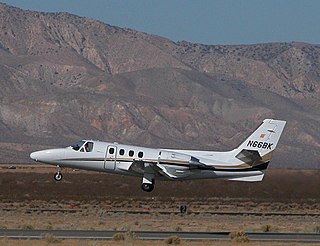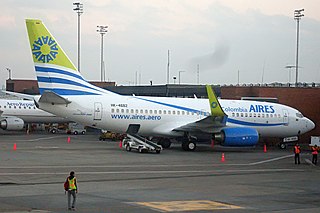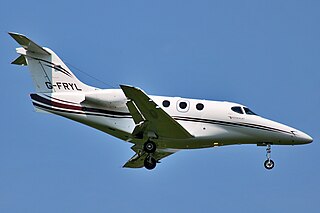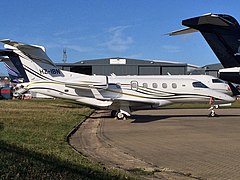
Blackbushe Airport is an operational general aviation airport in the civil parish of Yateley in the north-east corner of the English county of Hampshire. Built during the Second World War, Blackbushe is north of the A30 road between Camberley and Hook. For a time, it straddled this road, with traffic being stopped whilst airliners were towed across. The south side was used for aircraft maintenance, using wartime-built hangars. Today, only the part of the airfield that lay north of the A30 remains in active use. The historical name for the flat piece of land on which it is sited is Hartford Bridge Flats. The nearest towns are Yateley and Fleet.

China Airlines/Mandarin Airlines Flight 642 was a flight that crashed at Hong Kong International Airport on 22 August 1999. It was operating from Bangkok to Taipei with a stopover in Hong Kong.

The Embraer EMB-505 Phenom 300 is a light business jet designed and produced by the Brazilian aerospace manufacturer Embraer. Certified for single-pilot operations, it can carry up to 11 occupants. Work on the Phenom 300 started in response to customer demands for a larger business aircraft than the Phenom 100, a very light jet. While the design team originally intended for the aircraft to be a straightforward stretched derivative of the Phenom 100, a clean sheet approach was later adopted. The Phenom 300 featured more powerful engines, the addition of spoiler and winglets, along with an elongated cabin to accommodate more passengers. Several features, from its cabin and interior design to its landing gear and structure, can be traced back to the Phenom 100.

Aspen/Pitkin County Airport, also known as Sardy Field, is a county-owned public-use airport located three miles northwest of the central business district of Aspen, in Pitkin County, Colorado, United States. The airport covers an area of 573 acres (232 ha) at an elevation of 7,820 feet above mean sea level. It has one asphalt paved runway designated 15/33 which measures 8,006 by 100 feet.

Crossair Flight 3597 was a scheduled flight from Berlin Tegel Airport, Germany, to Zürich Airport, Switzerland. On 24 November 2001, the Crossair Avro RJ100 operating the route, registered as HB-IXM, crashed into a wooded range of hills near Bassersdorf and caught fire. Out of the 33 occupants, nine survived.

Crossair Flight 498 was a scheduled commuter flight from Zürich, Switzerland, to Dresden, Germany. On 10 January 2000, the Saab 340B operating the flight crashed two minutes after takeoff in the Swiss municipality of Niederhasli, killing all 10 passengers and crew. It was one of two fatal crashes for Crossair during its existence; the other was Crossair Flight 3597 which crashed less than two years later during approach to Zurich.

Britannia Airways Flight 226A was an international passenger flight from Cardiff, Wales to Girona, Spain, operated by charter airliner Britannia Airways. On 14 September 1999, the Boeing 757-204 aircraft suffered a crash landing and broke apart during a thunderstorm in Girona-Costa Brava Airport. Of the 236 passengers and nine crew on board, two were seriously injured and 41 sustained minor injuries. One of the passengers who had apparently sustained only minor injuries died five days later of unsuspected internal injuries. The aircraft involved in the crash, Boeing 757-204 registration G-BYAG, was damaged beyond economical repair and scrapped.

Southwest Airlines Flight 1455 was a scheduled passenger flight from McCarran International Airport, Las Vegas, Nevada, to Burbank-Glendale-Pasadena Airport, Burbank, California, that overran the runway during landing on March 5, 2000. The aircraft, a Boeing 737-3T5, registration N668SW, came to rest on a city street adjacent to a gas station. The National Transportation Safety Board found that the incident was due to the pilots attempting to land with excessive speed. They also found that the air traffic controller placed them in a position from which their only option was a go around. Two of the passengers were seriously injured, and there were many minor injuries. As a result of the incident, the airport installed an Engineered Materials Arrestor System at the east end of the incident runway. The aircraft was written off, making the incident the 10th hull loss of a Boeing 737-300. This was the first major accident in the airline's 29-year history.

Garuda Indonesia Flight 200(GA200/GIA200) was a scheduled domestic passenger flight of a Boeing 737-400 operated by Garuda Indonesia between Jakarta and Yogyakarta, Indonesia. The aircraft overran the runway, crashed into a rice field and burst into flames while landing at Adisucipto International Airport on 7 March 2007. Twenty passengers and one flight attendant were killed. Both pilots survived, and were fired shortly after the accident occurred. It was the fifth hull-loss of a Boeing 737 in Indonesia within less than six months and was the most recent accident with fatalities involving the airline.

British Airways Flight 38 was a scheduled international passenger flight from Beijing Capital International Airport in Beijing, China, to Heathrow Airport in London, United Kingdom, an 8,100-kilometre trip. On 17 January 2008, the Boeing 777-200ER aircraft operating the flight crashed-landed short of the runway at Heathrow. Of the 152 people on board, no fatalities resulted, but 47 people were injured, 1 of them seriously. The aircraft was written off, becoming the first hull loss of a Boeing 777.

On 30 March 2008, a Cessna 501 Citation crashed into a house in Farnborough, London (UK), near Biggin Hill Airport, from where the aircraft had taken off a short time before. There were no survivors among the five people on board, which included former racing drivers Richard Lloyd and David Leslie.

Turkish Airlines Flight 634 was a scheduled domestic passenger flight from Istanbul Atatürk Airport to Diyarbakır Airport in southeastern Turkey. On 8 January 2003 at 20:19 EET, the aircraft operating the flight, a British Aerospace Avro RJ100, struck the ground on final approach approximately 900 metres (3,000 ft) short of the runway threshold during inclement weather conditions. In the following collision with a slope, a post-crash fire broke out, killing 75 of the 80 occupants, including the entire crew. This is the deadliest aviation accident to involve the BAe 146.

AIRES Flight 8250 was a domestic scheduled passenger flight that on 16 August 2010 crashed on landing at night in poor weather on the Colombian island of San Andrés, killing two of the 131 people on board. The aircraft, an AIRES-operated Boeing 737-700, was arriving from the Colombian capital Bogotá when it heavily touched down short of the runway, breaking up in three sections.

Henan Airlines Flight 8387 was a domestic flight operated by Henan Airlines from Harbin to Yichun, China. On the night of 24 August 2010, the Embraer E190 operating the route crashed on approach to Yichun Lindu Airport in fog. 44 of the 96 people on board were killed. This was the first hull loss and the first fatal accident involving the Embraer E190 and as of 2025, the deadliest.

On 15 March 2005, a Britten-Norman Islander air ambulance, operated by Loganair, crashed off the coast of Scotland, killing both people on board.

East Coast Jets Flight 81 was a business jet flight operated by East Coast Jets that crashed on July 31, 2008 while attempting a go-around at Owatonna Degner Regional Airport near Owatonna, Minnesota, killing all eight occupants on board. The flight originated in Atlantic City International Airport, and was scheduled to land in Owatonna. The crew made a go-around attempt after the aircraft touched down, but it overran the runway, hit the instrument landing system localizer antenna at an altitude of approximately 5 ft (1.5 m), stalled and crashed, with the main wreckage coming to rest 2,400 ft (730 m) from the runway end.

Aeroméxico Connect Flight 2431 (SLI2431/5D2431) was a Mexican domestic scheduled passenger flight bound for Mexico City that crashed on takeoff from Durango International Airport on July 31, 2018. Shortly after becoming airborne, the plane encountered sudden wind shear caused by a microburst. The plane rapidly lost speed and altitude and impacted the runway, detaching the engines and skidding to a halt about 1,000 feet (300 m) beyond the runway. The plane caught fire and was destroyed. All 103 people on board survived, but 39 passengers and crew members were injured.

Air India Express Flight 1344 was a scheduled international flight on 7 August 2020 from Dubai, United Arab Emirates, to Kozhikode, India, landing at Calicut International Airport. The flight was part of the Vande Bharat Mission to repatriate Indian nationals stranded due to the COVID-19 pandemic. The flight crew aborted two landing attempts because of heavy rain and tailwind. On the third landing attempt, the aircraft touched down on runway 10, but skidded off the end of the tabletop runway and slid down a 9–10.5 m (30–35 ft) slope, killing 19 passengers and both pilots. The 4 cabin crew members and 165 passengers survived, 110 people were injured. This was the second fatal accident involving Air India Express, after the 2010 Mangalore crash.

On 17 August 2023, a Beechcraft 390 Premier I business jet crashed onto an expressway interchange near Elmina in Sungai Buloh, Selangor, Malaysia, killing 10 people. The aircraft was travelling from Langkawi International Airport to Sultan Abdul Aziz Shah Airport when it crashed two minutes prior to landing.



















